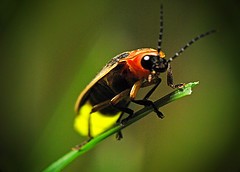The presence of Japanese beetles on your plants will draw in more Japanese beetles, from certain pheromones they release. If you can get rid of the beetles that are already present, then less new beetles will be attracted to your plants.
Here are a few simple methods for getting rid of Japanese beetles.
Pick them off and squish them
Yes, this is the simplest, lowest tech way to get rid of Japanese beetles if you're not squeamish, and if there aren't too many (you can decide what is too many for you). Do this every day while Japanese beetles are present in your area.
Japanese beetles are active for 4 - 6 weeks during the summer, but they may be present for only part of that time on your plants.
A variant of this method is to vacuum them off your plants. Go carefully so as not to further destroy your own plants! And empty the bag or cannister afterward, otherwise the dead bugs will start to smell.
Flick them into soapy water
This turned out to be a very simple and effective method for me to get rid of the Japanese beetles on my husband's canna lilies.
This is a variation of picking them off, but I didn't have to squish them and I didn't even really have to touch them except to flick.
I used about a tablespoon of dish soap in 2 cups of water in a plastic bowl. With bowl in one hand, I flicked the Japanese beetles into the bowl with the other hand. You can brush them into the water with a gloved hand if you don't want to touch them at all. It also works to tap the leaf with the bug over the soapy water.
The Japanese beetles die in the soapy water because it destroys their cell membranes, and their bodies dehydrate.














 Singer-Songwriter Ellis Performs From the Hearton 06/03/2013
Singer-Songwriter Ellis Performs From the Hearton 06/03/2013
 The Light-Weight SteriPen Water Purifier for Camping or Travelon 01/18/2015
The Light-Weight SteriPen Water Purifier for Camping or Travelon 01/18/2015
 Inexpensive Gift Ideas For Coffee Loverson 11/28/2014
Inexpensive Gift Ideas For Coffee Loverson 11/28/2014
 Very Simple Cranberry Sauceon 11/26/2014
Very Simple Cranberry Sauceon 11/26/2014



Have you had problems with Japanese beetles? How have you gotten rid of them?
Here for my spring review to avoid Japanese beetles again this season.
Great info. Fortunately, this is a problem I don't have in my garden.
No, I didn't have problems with Japanese beetles yet, but I have been battling wars with plant lice for some time. Soapy water didn't work for me, but vacuuming would be interesting alternative. Than, by coincidence I found a lady bug on my plants and the problem was solved fast.
Thanks for these good eco-friendly tips. (And some fun too:))
These pesky beetles can be a huge problem here in Ohio, thanks for the tips! We once had them so bad you couldn't open the door without them getting in the house. We'd notice them crawling on the walls later at night when we slowed down to relax. Annoying and very hard to get off the ceilings. Don't want that to happen again. :)K